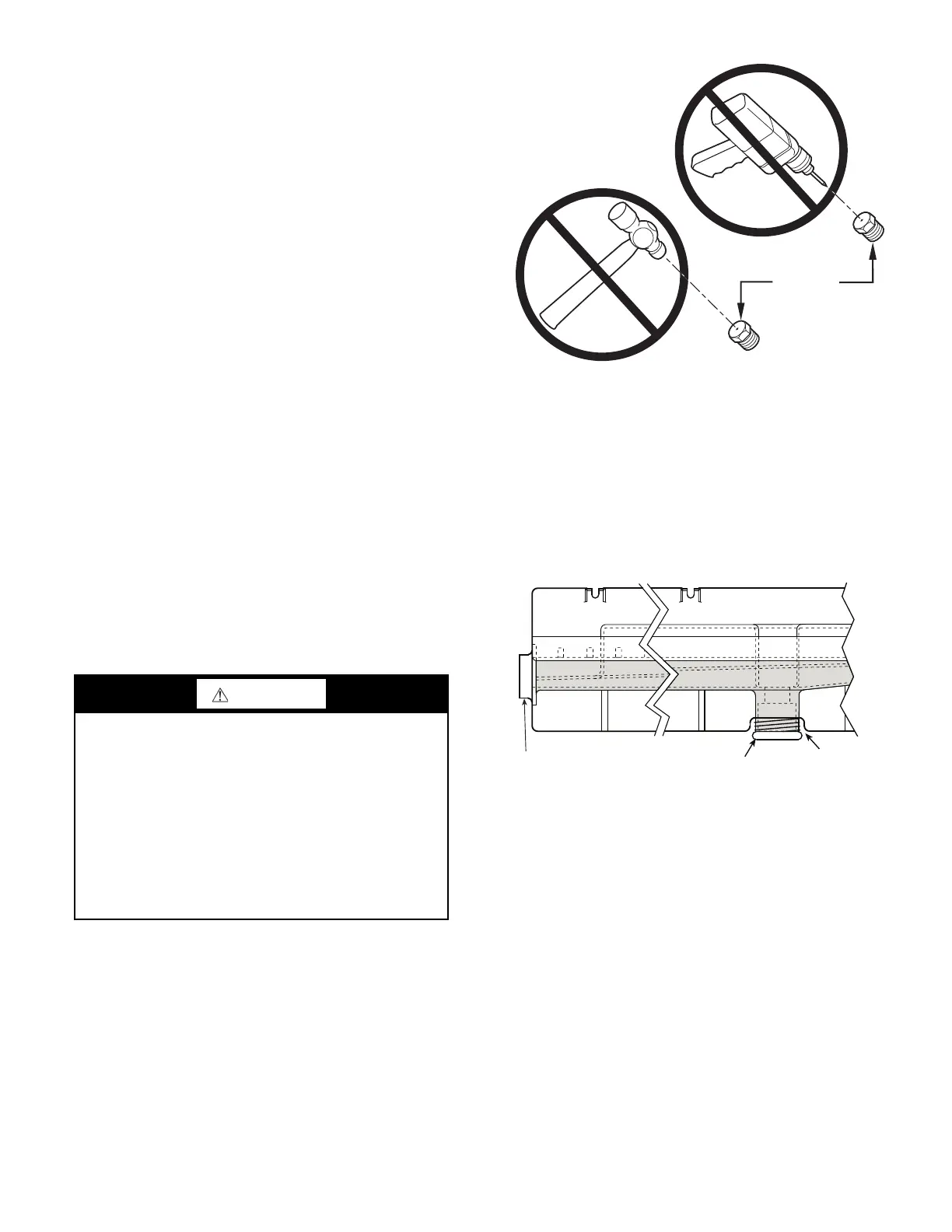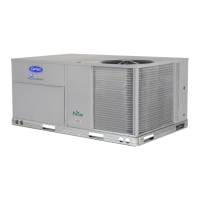19
When installing the gas supply line, observe local codes per-
taining to gas pipe installations. Refer to the NFPA 54/ANSI
Z223.1 NFGC latest edition (in Canada, CAN/CSA B149.1).
In the absence of local building codes, adhere to the following
pertinent recommendations:
1. Avoid low spots in long runs of pipe. Grade all pipe
1
/
4
-
inch in every 15 ft (7 mm in every 5 m) to prevent traps.
Grade all horizontal runs downward to risers. Use risers to
connect to heating section and to meter.
2. Protect all segments of piping system against physical and
thermal damage. Support all piping with appropriate
straps, hangers, etc. Use a minimum of one hanger every 6
ft (1.8 m). For pipe sizes larger than
1
/
2
-in., follow recom-
mendations of national codes.
3. Apply joint compound (pipe dope) sparingly and only to
male threads of joint when making pipe connections. Use
only pipe dope that is resistant to action of liquefied petro-
leum gases as specified by local and/or national codes. If
using PTFE (Teflon*) tape, ensure the material is Double
Density type and is labeled for use on gas lines. Apply
tape per manufacturer’s instructions.
4. Pressure-test all gas piping in accordance with local and
national plumbing and gas codes before connecting piping
to unit.
NOTE: Pressure test the gas supply system after the gas supply
piping is connected to the gas valve. The supply piping must be
disconnected from the gas valve during the testing of the piping
systems when test pressure is in excess of 0.5 psig (3450 Pa). Pres-
sure test the gas supply piping system at pressures equal to or less
than 0.5 psig (3450 Pa). The unit heating section must be isolated
from the gas piping system by closing the external main manual
shutoff valve and slightly opening the ground-joint union.
Check for gas leaks at the field-installed and factory-installed
gas lines after all piping connections have been completed. Use
soap-and-water solution (or method specified by local codes
and/or regulations).
NOTE: If orifice hole appears damaged or it is suspected to have
been re-drilled, check orifice hole with a numbered drill bit of cor-
rect size. Never re-drill an orifice. A burr-free and squarely
aligned orifice hole is essential for proper flame characteristics.
Fig. 24 — Orifice Hole
Step 11 — Install External Condensate Trap and
Line
The unit has one
3
/
4
-in. condensate drain connection on the end
of the condensate pan and an alternate connection on the bot-
tom. See Fig. 25. Unit airflow configuration does not deter-
mine which drain connection to use. Either drain connection
can be used with vertical or horizontal applications.
To use the alternate bottom drain connection, remove the red drain
plug from the bottom connection (use a
1
/
2
-in. square socket drive
extension) and install it in the side drain connection.
Fig. 25 — Condensate Drain Pan (Side View)
The piping for the condensate drain and external trap can be
completed after the unit is in place. See Fig. 26.
NOTE: Trap should be deep enough to offset maximum unit static
difference. A 4-in. (102mm) trap is recommended.
WARNING
FIRE OR EXPLOSION HAZARD
Failure to follow this warning could result in personal
injury, death and/or property damage.
• Connect gas pipe to unit using a backup wrench to
avoid damaging gas controls.
• Never purge a gas line into a combustion chamber.
• Never test for gas leaks with an open flame. Use a
commercially available soap solution made specifical-
ly for the detection of leaks to check all connections.
• Use proper length of pipe to avoid stress on gas con-
trol manifold.
BURNER
ORIFICE
DRAIN
(FACTORY-INSTALLED)
PLUG
CONDENSATE PAN (SIDE VIEW)
STANDARD
SIDE DRAIN
ALTERNATE
BOTTOM DRAIN
* Teflon is a registered trademark of DuPont.

